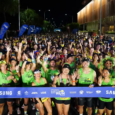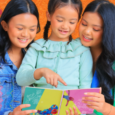This year’s graduating class of Polytechnic University of the Philippines under College of Architecture and Fine Arts- Department of Interior Design will be launching their exhibit entitled “Salu-Salo – Taste the by Gathering of Filipino Fiestas through Interior Design” this coming April 1, 2019 at Ayala Malls Circuit- Makati.
The exhibit will be showcasing nine (09) enterprising and innovative spatial interpretations of selected Filipino Fiestas’ along with their diverse food culture through a design that aims to give a whole new dining experience as it gathers people of all kinds and manners. The goal of this project is to promote, educate, and showcase to the masses the various Fiestas that occur all over the Philippines and the range of food served by our deep-rooted celebration of culture. All of that will be incorporated into different types of restaurant spaces, and completely will be the creation of the students of PUP BS Interior Design Graduating Class of 2019.
Ani Festival
Area: Diner
Designers: Mico, Bianca Marie, Resuello, Agatha Jamie, Valdez, Reyel Ann Marie
Concept & Rationale:
The Ani festival serves as a thanksgiving event to the Dingras farmers as well as
the fertility of their land and abundant harvests as the agriculture product in Dingras.
Food from breakfast to dinner can be served, for the Diner is a home away from
home. The main dish we intend to serve in our Diner is the famous “Pinakbet Pizza”
because of the varieties of vegetables which is the representation of Ani Festival.
“Mangan” is the Ilokano term for “Kain” an invitation to our visitors to enjoy the
food and just eat. Through the interiors, we want to showcase Ilocos and their culture,
giving the visitors an insight of what it’s like to be part of the Ani festival.
Pintados- Kasadyan Festival
Area: Dessert bar
Designer: Divinagracia, Christine Kassel, Nazareno, Freya Dale, Pineda, Beatriz Joyce
Concept & Rationale:
Unity and togetherness are some of the words that’s needed in a family. For us Filipinos, family is the most important thing. We celebrate unity in many ways, one is celebrating Town fiestas. Town Fiestas are celebrations of giving thanks to the Almighty One for giving us strength as family, for all the storms and struggles we go through. During these fiestas, one of the main attractions are the kakanin or rice cakes. Kakanins are always present in Filipino celebrations and it is believed to make families stronger and tighter together by its sticky texture. It is a proof that even if the Spanish colonization removed our original identity just like what the Pintados-Kasadyan Festival depicts, there are things like kakanins that’ll keep the Filipino people united. And even though present Filipino culture is a melting pot of culture, kakanins and fiestas are few of the things that’ll remind us that we are not just Filipinos but we stand as one country one family.
Timpupo Festival
Area: Bistro Bar
Designer: Barlaan, Kimberly Cane, Cervalez, Alyssa Jane, Ronda, Angelito
Concept & Rationale:
A bar is a drinking establishment whose primary function is the serving of alcoholic beverages for consumption on the premises. Some establishments may also serve food, or have entertainment. Meanwhile, the term bistro only refers to the bar aspect of a restaurant. After all, many bars offer a relaxed atmosphere without ever being thought of as bistros, likely because food is rarely the focus. However, if you pair your alcohol offerings with your menu, carefully weaving the flavors to complement, you can make alcohol a significant part of your overall experience.
Kidapawan City is hailed as the City of Fruits and annually celebrated the Timpupo Festival around August. Timpupo is a generic term among Manobos for “abundant harvest”. Home of the durian, lanzones, mangosteen, rambutan and banana plantations, and the province is known for rich soil and chill weather.
Through the festival, the government wants to help their own fruit farmers to improve their income, and a venue to promote the diverse culture and traditions of the local indigenous people. Among the programs are ‘eat-all-you-can’ event sponsored by the local government. For the locals, there is a competition themed “Ang Pinaka” fruit contest. This contest gives credit to those who harvested the longest banana or the biggest durian.
Kaamulan Festival
Area: Carinderia
Designers: Alcobera, Nikka Joy, Olivare, Joshua, Sanje, Shella, Songcuan, Glezzy
Concept & rationale:
Carinderia is a local commercial establishment that sells a wide variety of home-cooked Filipino meals and is recognized as a native food shop that caters to different types of people. One distinguishing feature of Carinderia that makes it different from other dining establishment is the absence of menu boards and menu books, creating a unique and unusual experience when it comes to ordering food through the “turo-turo” manner (pointing technique), as customers literally point out their orders at the displayed food samples and the dish is served shortly after, earning its designation as “The Genuine Filipino Dining Experience”. Serving affordable home-cooked Filipino specialties, Carinderia is the perfect outlet to promote the country’s culinary and social identity, giving not only Filipinos but also travelers from around the world a taste of the “Pinoy Culture” through recipes that were inherited and developed from our ancestors; a dining experience close to our hearts.
Kaamulan Festival is known as the most authentic Ethnic festival in the Philippines and is annually held in Malaybalay, Bukidnon. This festival is popular in Mindanao as its main purpose is to gather and unite the seven ethnic tribes of Bukidnon namely Bukidnon, Higaonon, Manobo, Talaandig, Matigsalug, Umayamnon and Tigwahanon. It came from the Binukid word “Amul” which means “to gather”. This connects to the Carinderia which primarily functions as a place where people of all kinds gather together to eat affordable home-cooked Filipino meals. Some famous dishes usually served in the province of Bukidnon are Sinuglaw (Sinugba and Kinilaw raw fish), Lyurot na Ito (Mudfish cooked in bamboo chambers), and Binaki (steamed corn sweet tamales). To pay homage to the Kaamulan festival, the interior design was inspired not only by the local dishes that promote the seven different ethnic groups but also by the festival’s culmination and highlight of the celebration which is the Ethnic Street Dancing competition that showcases the stories of the different tribes through music and dancing. Using the concept of uniting and incorporating the rich cultural heritage of the seven different ethnic groups in one space, the designers aim to break the common perception towards the famous local food stall by enhancing the Carinderia experience and the Carinderia itself.
Panagbenga Festival
Area: Cafe
Designers: Durognan, Justine, Garganta, Maria Pauline, Ladiao, Yaakov
Baguio City in the Philippines is most notably known as the summer capital of the country. This festival is held yearly during month of February. This festival showcases the various floats of floral together with their native dances. Every February where Valentine’s day is celebrated, the city of Pines is purely a paradise of sweetest senses given by various flowers. A local word in Baguio “Kankana-ey” which means “Seasons of Blooming” defines the city as home to the beautiful flowers.
A bloomy dining experienced inspired by the colorful festival of Baguio, Panagbenga Festival. Throughout the design, it depicts how colorful the festival not only in physical appearance but also how colorful their rich culture is. Notable gigantic flower floats, street dancing and ethnic culture was taken as inspiration in design making. This Café serves delicacies from Baguio like strawberry sweets and many more coffee drinks. Take time to indulge taste, smell and sight as this café take you to a next level of Panagbenga Festival together with Baguio’s rich culture experience.
Pahiyas Festival
Area: Panciteria
Designers: Batingan, Rolando Jr., Gibaga, Stiffany, Nunez, John Alvin
Concept & Rationale:
Quezon Province is known for its extravagant festival that is celebrated on the 15th of May. It is the most colorful harvest in the Philippines and is celebrated to honor the saint of the farmers, San Isidro De Labrador. Furthermore, Lucban, Quezon is also known for its famous delicacy- Pansit Habhab. Vinegar is added to add flavor to the noodles and the unique way of eating Pansit Habhab is by serving it in a banana leaf and is eaten by hand only.
Through the use of Pahiyas Festival’s elements such as colors, form, and textures, the designers came up with a design of a Panciteria that will showcase the culture and the famous festival in Quezon Province. It was thoroughly planned, from its layout to its design from floor, wall, and ceiling. This will give a feeling like home through its brown and woody textures and the natural woods like bamboos that are present in the design. Through its ambience, the customers will surely comeback and will enjoy the dining experience in Hab-Hab Lab.
MassKara Festival
Area: Casual Dining Restaurant
Designers: Canonoy, Charlie, Garcia, Shannine Dane, Sandoval, Maria Kayla
Concept & Rationale:
MassKara Festival is a “festival of smiles” that is being held in Bacolod City to pull the residents out of the pervasive gloomy atmosphere brought by the Don Juan Tragedy and to live up to the City’s moniker as the “City of Smiles” as well.
This festival has become the design concept of designers and applied it to the interior space (Casual Dining Restaurant) to promote its culture and to let the customers have a unique and exciting dining experience by the sweet and positive ambiance that it gives, lifting up their moods through the elements of the interior and through the food that it serves.
Kadayawan Festival
Area: Buffet Restaurant
Designers: Castillo, John Raymond A., Laurente, Greg Renz, Marasigan, Bernadette
Concept & Rationale:
Kadayawan Festival is a celebration of Good Harvest! This globally famous festival is a weeklong celebration and thanksgiving for nature’s bountiful harvest. Derived from the historic word “Madayaw”, a warm and friendly greeting also used to explain a thing that is good, valuable, superior or profitable. During the celebration, they prepared foods usually seafood with some fruits like durian and drinks that were displayed on mats as villagers give their respect and thanks for the year’s abundance. The festival is also rooted in time of how the province of Davao maintained a celebration of thanksgiving with no tribal borders, talking about the lumads, moro and the Christian group. They are recognized because of their present-day influence.
Madayaw buffet restaurant would be the best type of dining space to cater all the dishes of the region since it is a celebration of a good harvest. Applying the three important icons of the feast- Philippine eagle, orchids and durian which also symbolizes the three people of davao, the Christians, muslims and the moros. It is a space that is designed without cultural behaviors.
Paraw- Regatta Festival
Area: Noodle House
Designers: Bancinillo, Marvin, Gutierrez, Cydel, Marmeto, Marjorie, Nota, Frannie
Paraw Regatta Festival is held every February in the Villa de Arevalo district Iloilo City Philippines. It showcases the race of sailboats, which features the Visayan double outrigger sailboat; the Paraw.
La Paz Batchoy is the chosen food to be applied in the 5M x 6M noodle house. The colors and the features of the said food is used as an element in the interior space.





